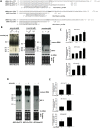A tRNA-derived RNA Fragment Plays an Important Role in the Mechanism of Arsenite -induced Cellular Responses
- PMID: 30442959
- PMCID: PMC6237853
- DOI: 10.1038/s41598-018-34899-2
A tRNA-derived RNA Fragment Plays an Important Role in the Mechanism of Arsenite -induced Cellular Responses
Abstract
Chronic exposure to environmental heavy metals is a worldwide health concern. It is acknowledged to be an important cause of lower respiratory tract damage in children. However, the molecular mechanisms underlying the heavy metal-induced cellular stress/toxicity are not completely understood. Small non-coding RNAs (sncRNAs), such as microRNAs (miRNA) and more recently identified tRNA-derived RNA fragments (tRFs), are critical to the posttranscriptional control of genes. We used deep sequencing to investigate whether cellular sncRNA profiles are changed by environmental heavy metals. We found that the treatment of arsenite, an important groundwater heavy metal, leads to abundant production of tRFs, that are ~30 nucleotides (nts) long and most of which correspond to the 5'-end of mature tRNAs. It is unlikely for these tRFs to be random degradation by-products, as the type of induced tRFs is heavy metal-dependent. Three most inducible tRFs and their roles in arsenite-induced cellular responses were then investigated. We identified that p65, an important transcription factor belonging to NF-κB family and also a key factor controlling inflammatory gene expression, is a regulated target of a tRF derived from 5'-end of mature tRNA encoding AlaCGC (tRF5-AlaCGC). tRF5-AlaCGC activates p65, subsequently leading to enhanced secretion of IL-8 in arsenite response. In this study, we also identified that endonuclease Dicer and angiogenin temporally control the induction of tRF5-AlaCGC, providing an insight into the control of tRF biogenesis and subsequently the prevention of cellular damage.
Conflict of interest statement
The authors declare no competing interests.
Figures




References
-
- U.S. Dept. of Health and Human Services Washington DC Agency for Toxic Substances and Disease Registry, “Toxicological Profile for Arsenic,“in). (https://www.atsdr.cdc.gov/toxprofiles/TP.asp?id=22&tid=3) (2007) - PubMed
-
- Mazumder DN. Effect of drinking arsenic contaminated water in children. Indian Pediatr. 2007;44(12):925. - PubMed
Publication types
MeSH terms
Substances
Grants and funding
LinkOut - more resources
Full Text Sources

